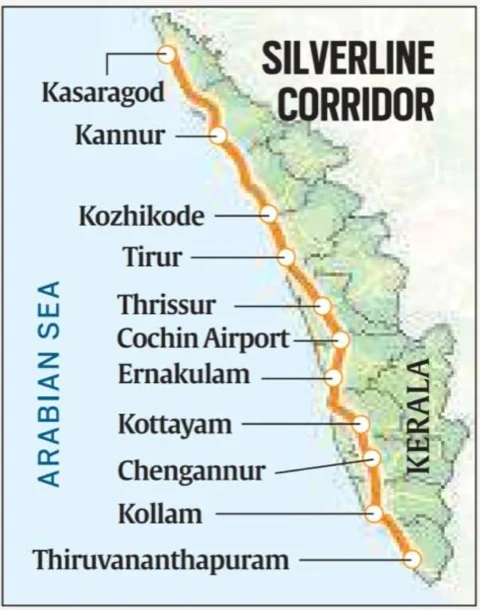UPSC Articles
ECONOMY/ GOVERNANCE
- GS-3: Economy & developmental challenges
- GS-2: Government policies and interventions for development in various sectors and issues arising out of their design and implementation.
Kerala’s SilverLine project
Context: Despite the protests taking place across Kerala against SilverLine, state government remains firm on implementing the project.

Image Source: Indian Express
What is Kerala’s SilverLine project?
- The proposed 529.45-km line will link Thiruvananthapuram in the south to Kasaragod in the north, covering 11 districts through 11 stations.
- When the project is completed, one can travel from Kasaragod to Thiruvananthapuram in less than four hours at 200 km/hr.
- On the existing Indian Railways network, it now takes 12 hours.
- The deadline for the project, being executed by the Kerala Rail Development Corporation Limited (KRDCL), is 2025.
- KRDCL, or K-Rail, is a joint venture between the Kerala government and the Union Ministry of Railways created to execute big railway projects.
- According to K-Rail, the project will have trains of electric multiple unit (EMU) type, each with preferably nine cars extendable to 12. A nine-car rake can seat a maximum of 675 passengers in business and standard class settings.
What was the need for the SilverLine project?
- Urban policy experts have long been arguing that the existing railway infrastructure in Kerala cannot meet the demands of the future.
- Most trains run at an average speed of 45 km/hr due to a lot of curves and bends on the existing stretch.
- The government claims the SilverLine project can take a significant load of traffic off the existing stretch and make travel faster for commuters, which in turn will reduce congestion on roads and help reduce accidents.
- The government claims the line will also
- Reduce greenhouse gas emissions
- Help in expansion of Ro-Ro services
- Produce employment opportunities
- Integrate airports and IT corridors,
- Enable faster development of cities it passes through.
Where does the project stand now?
- The state government has begun the process of land acquisition after the Cabinet gave its approval in June 2021. Out of 1,383 hectares needed to be acquired, 1,198 hectares will be private land.
- The Cabinet has also approved administrative sanction to get Rs 2,100 crore from the Kerala Infrastructure Investment Fund Board (KIIFB), the investment arm of the government.
- While Kerala Chief Minister has written to Prime Minister Modi requesting his ‘personal intervention’ to give all necessary clearances, the Centre has only given an in-principle approval to the project.
- The line is expected to be constructed using equity funds from the Kerala government, the Centre and loans from multilateral lending agencies.
- A part of the detailed project report (DPR) was released by the government following demands by opposition parties and activists.
- Also, the state government is planning to issue a ‘white paper’ on the project, explaining its benefits and potential in the future. Members of the planning board will hold extensive consultations as part of the drafting of the ‘white paper’.
Why are there protests against the project?
- Political parties and citizen outfits have been spearheading separate protests.
- A petition signed by 17 Opposition MPs from the state said the project
- Project was financially unviable
- Would sink the state further into debt.
- Would lead to the displacement of over 30,000 families
- An “astronomical scam in the making”
- Green activists allege that SilverLine would cause great environmental harm as its route cuts through precious wetlands, paddy fields and hills.
- Citizen outfits allege that building of embankments on either side of the major portion of the line will block natural drainage and cause floods during heavy rains.
Connecting the dots:














